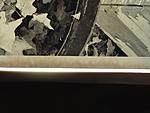Ben,
I'm placing my money on inadequate fixation then. If not that, then inadequate washing before toning; maybe 5-10 minutes isn't enough.
Maybe my workflow will help you, since yours seems similar already.
During my "printing" sessions, I develop, stop and give fix 1 (Ilford Rapid Fixer 1+9 for 1.5-2 minutes). I then wash (60 minutes in a slot-type washer) and dry the prints. Those that make the final cut after that get collected over time and go to a toning session.
During my "toning" session, I soak the prints and give them fix 2, which is always freshly-mixed before the session (again, Ilford Rapid Fixer 1+9). Prints then go from fix 2 directly to the toning bath. After the desired amount of toning has been reached, the prints go directly to a hypo-clearing bath (mixed from scratch; sodium sulfite and bisulfite). From there, a quick rinse and into the washer. I don't worry about going directly to the hypo-clearing bath, although the carried-over toner does diminish the capacity. I have lots of sulfite and bisulfite on hand and can mix more easily; having the extra tray and step would be a lot more of a hassle.
Two things I really recommend.
First is two-bath fixing. By mixing the second bath fresh and keeping the throughput low, you are always ensured of well-fixed prints (more later).
Second is not trusting the Ilford short-fix sequence. In theory, using strong fix for a short time should fix the emulsion without letting fixer soak into the paper base and thereby shorten wash times. I imagine if I were working with one-bath fixation (and the small capacity it requires) and small prints, it would work fine. In practice, however, keeping the fix fresh enough (only 10 8x10s per liter, remember) and the fixing time to just 60 seconds is difficult for me. Heck, a 16x20 print takes 20+ seconds to drain completely - do I include that time in the total fixing time? Or not? Fixing longer than the 60 seconds lets the paper base get saturated with fixer, which requires a longer wash time. I'm happy to wash longer

Still, if you want to try, here's Ilford's optimum permanence sequence:
https://www.ilfordphoto.com/ilford-o...nce-fb-papers/
Note that they give a separate sequence for selenium toner (scroll down a bit) and that they transfer directly from fixer to toner without an intermediate rinse. Note also that the wash time is rather long; 30 minutes.
Finally, a word about fixer longevity. If you use Rapid Fixer one bath and want to process for optimum permanence, 10 8x10s per liter is your limit. For "commercial" standards, Ilford says 40 8x10s per liter. With a two-bath regime (either 1+4 or 1+9) the capacity is increased: 35-40 8x10s per liter of bath one (remember, there's a bath two as well, so overall it's about 20 8x10s per liter for the whole thing). That's throughput; keep count of your prints (and test strips, etc.) and forget the hypo-check; it's not nearly sensitive enough for print fixer (barely enough for film fixer). And, keep track of how long you keep your fix. It will last 7 days in an open tray, one month in a partly-full bottle and six months in a full, tightly-capped bottle. I rarely keep fix around for 30 days...
With two-bath fixation, after you run 35-40 prints through bath two, you can turn around and use it for bath one for the next printing session. That makes it even more economical.
FWIW, I've been using the above regime for 30+ years and never have a stained print...
Hope this helps,
Doremus




 Reply With Quote
Reply With Quote


Bookmarks